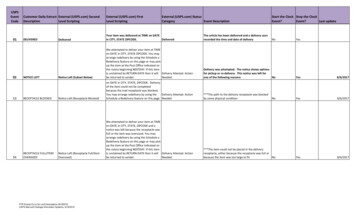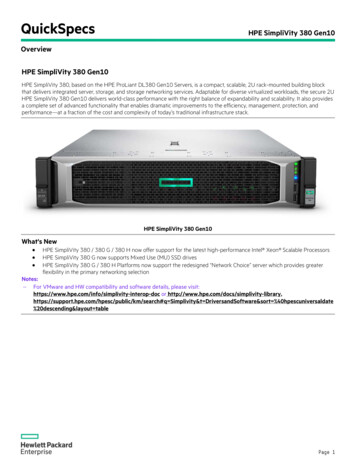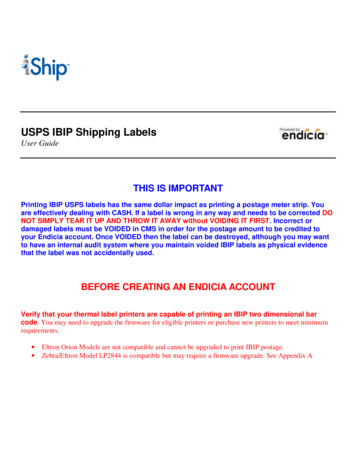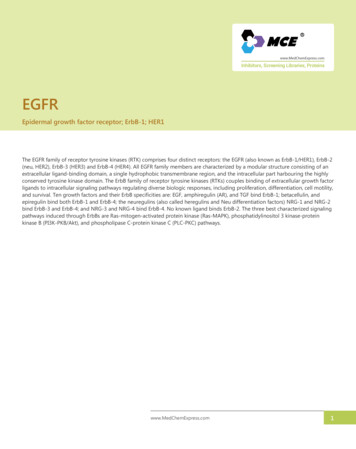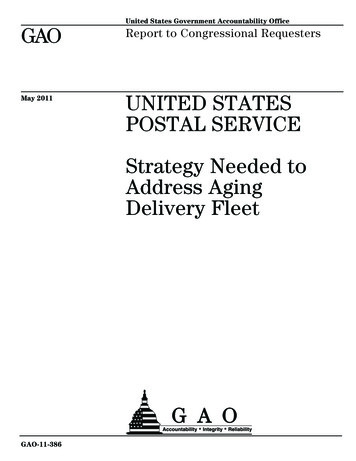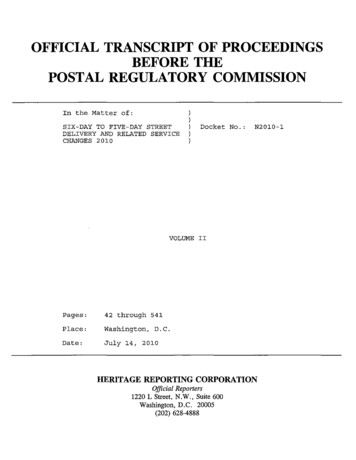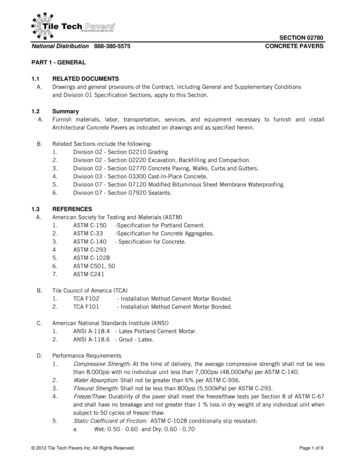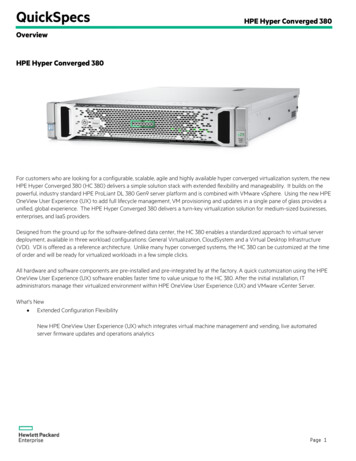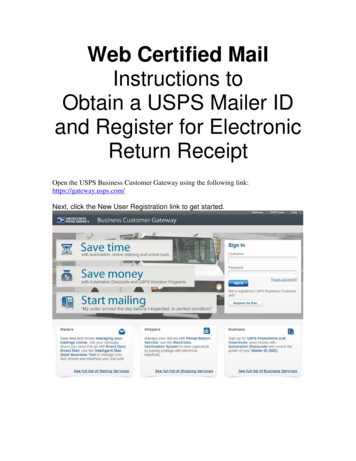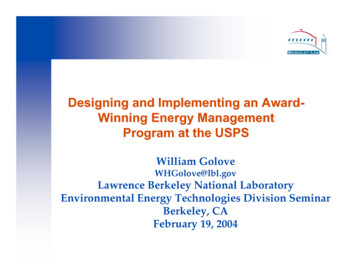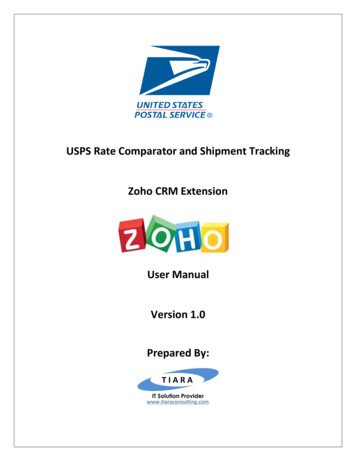
Transcription
USPS-LR-I-380Redacted Inspection Service and Inspector General AuditReports Provided in Response to Interrogatory DBPIUSPS-130ICONTENTSRegistered Mail Procedures (February, 1999)External First-Class (EXFC)/Collections (April, 1998)2-3 Day and Priority Mail (August, 1998)EXFC Operational Review (April, 1998)Government Mails Section (September, 1999)
DistrictManagerSUBJECT: RegisteredMail Procedures-Attached is a final report reqarding our self-initiatedreview of Registered Mail. RecommendationsHandling Procedures in theand management’sresponports, a matrix ofdeficiencies found, and a self-compliancechecklist were furnished in the draftreport, and are not contained in this report.IThe purpose of our review was to determine if the new registered mail handlingprocedures,implementedr,ationwidein 1997 were being followedby themThese changes were designed to provide increasedsecurity and individual accountabilityto registered mail and reflect changes inmail processing, mail transport equipment, and banking procedures.During our review we visited all 4 plants in the district,and 10 AssociateOffices throughoutthe district providing a sampling of large and small offices.We found the need for improvementto increase the security of registered mail.This would be accomplishedby using secure containers,documentingthetransfer of accountability,and incorponingbetter physical security.If you have any questions,Aponte at (7321-81 S-3252.D.V. LandisiPostal InspectorSenior Plsnt ManagerAttachmentpleasecall me at (732)-81%4368M. ApontePostal Inspectoror Inspector
PLATFORM SECURITY - PLANTSFindingSecurity and individual accountabilityover registered items while on theplatform at Processing and Distribution Centers can be improved.The newregistry procedures require use of secure containers for registered items whileon the platform, as well as a system to maintain individual accountabilityoverregistered articles at all times.SecuritvThree of the 4 plants we reviewed did not use secure containers for i,nboundregistered pouches on the loading dock. We found these offices usingpostcons or hampers to store registered items on the platform awaiting transferto the registry unit. We also observed clerks leaving these open containersunattended for up to ‘/i hour. Secure containers were designed and placed intouse for the sole purpose of providing added security and accountabilitytoregistered mail. Failure to use them makes high-value items more vulnerable toloss. The basic feeling at the plants was that the containers were a nuisanceto use, or, that postcons were secure enough as long as the clerk was standingnearby.AccountabilityAt 2 of the 4 plants, we found a lack of accountabilityregarding the transfer ofregistered articles from the clerk receiving the article on the platform and theclerk or mailhandler transponingthe registered articles to the registry cage. Atthese 2 offices, one clerk would receive the pouches from the HCR or MVSdriver and place them in a container.A second employee would take thiscontainer of registered items and move it to the registry cage without anydocumented transfer of accountabilityfrom the receiving clerk to the transferclerk. Individual accountability,a primary tenet of registered mail, wascompletely lacking during this time period.We recommended the Senior,PlantL ,ensure all plants:Manager,r1. Use secure registered mail containers on the platforms as required inHandbook DM-901, Registered Mail Handbook, Section 612.1.2. Maintain individual accountabilityover registered items at all times throughdocumented transfer of accountabilityas required by Sections 333.1 and721.21 of Handbook DM-901.NEWARKonlsloN HEAclO”ARTERSP. 0. 90x 509NEWARK NJ 07101-0509TELEPWNC: 973 693.5400FAX: 973 693.5459
Management’sResponseManagement stated all plants have obtained and reviewed a copy of DM-901.Registry Supervisors of Distribution and Operations have been assigned oneach tour at each plant to ensure compliance with the DM-901.Managementalso stated:llSecure containers are being used on the platform612.1 of DM-901.as requiredin Sectionindividual accountabilityis maintained over registered items at all timesthrough documented transfer of accountabilityas required in Sections333.1 and 721.21 of DM-901.The District will monitor compliance through use of a self-compliancerecommended in our finding “Self-AssessmentCompliance Checklist.”NEW*RI DlVlSlON HE*DOUARTERSP. 0. BOX 509NEWlRX NJ 07101-0509TfLEPWONE: 973 693.5400FAX: 973 693.5459review
REGISTERED MAIL VIA HIGHWAYCONTRACTROUTEFindingNot all offices were requiring Highway Contract Route IHCRJ drivers sign Form3854, Registry Dispatch Form, accepting accountabilityfor the registered mailthey were transporting.We also found plants and Associate Offices were notalways using the “Nil-Bill” system to aid in timely detection of lost registrypouches.Form 3854A primary component of the new registered mail handling procedures isestablishing additional accountabilityfor HCR drivers transporting registeredmail. Under the new guidelines, drivers transporting registered items arerequired to sign the registered dispatch bill accepting accountabilityfor themail. When the registered items are delivered to the plant, the driver isrelieved of accountabilitywhen the accepting clerk signs the dispatch bill. Wefound 3 Associate Offices reviewed were not requiring HCR drivers to signForm 3854 accepting accountabilityfor registered mail. One postmasteradvised the HCR driver refused to sign for the pouch and the postmaster neverpursued the issue. It appeared the other offices were unaware of the newinstructions.Nil-Bill SystemUnder the Nil-Bill system, Associate Offices are required to send registeredpouches to the plant even if there is no outgoing registered mail. There will beThe purpose of the system is to aida pouch accounted for from every office.in timely detection of a missing registry pouch so the Inspection Service canbe notified and begin investigatingimmediately.We found 3 Associate Officesdid not use the Nil-Bill system, and 3 plants did not maintain an AssociateOffice check-off sheet on the platform, rendering the Nil-Bill systemmeaningless.In all cases they were unaware of the necessity.We recommended the District Manager, mtissueinstructions to all Associate Offices requiring the use of Forms 3854 for HCRdrivers transporting registered mail. We also recommended the DistrictManager require all offices comply with the Nil-Bill procedures as specified inSections 423,432,564, and 721.1 of DM-901,We recommended the Senior Plant Manager,a,require all plants comply with the Nil-Bill system by using the-NfW*RI OmstoN HE*W”*RTERSP. 0. Box 509NEWARK NJ 07101-0509TREPHONE: 973 693 5400FAX: 973 693.5459ce
.Associate Office check-off sheet. We also recommended plants identifydelivery units not using Forms 3854 as required and notify tht managers for follow-up attention.Management’sthoseResponseManagement stated all offices will utilize Forms 3854 for.HCR driverstransponing registered mail as required in Sections 431 and 432 of DM-901.Additionally,all offices will implement the Nil-Bill procedures as specified inSection 564 of DM-901.The District will monitor compliance through use of a self-compliancerecommended in our finding “Self-AssessmentCompliance Checklist.”INEWARK 0l”lsioN HLADO”.RTERSP. 0. 90x 509NPu*RI NJ 07101-0609TELEPHONE: 973 693.5400FAX: 973 693.5459review
SECURITY OF REGISTERED MAIL - ASSOCIATEOFFICESFindingOur observations of registered mail handling at delivery units disclosednumerous security and accountabilitydeficiencies.These deficiencies occurreddue to a lack of management oversight and knowledge of requirements.Physical SecurityDuring our reviews, we found the followingsecurity of registered mail:lll.problems involvingphysicalKeys to rotary locks, registry cages, vestibule security containers notalways secured.Combinations to vaults and security containers not changed as required.Sign-in sheet for registry cage not always used as required.Registered articles at times left unsecured while awaiting dispatch or uponarrival from plant.Accountability.I/The most widespread problem we found relating to individual accountabilityinvolved registered articles accepted over the window.At 6 offices, thesearticles were put in a common drawer, accessible to all window clerks, or anyother employee near the screenline.We also found registered pouches arrivingat the main office from stations or branches were not always listed on dispatchbills so accountabilitycould be properly transferred from the station to the mainoffice.RecommendationreinforceWe recommended the District Manager, wthe need for all offices ?o provide proper security to registered articles. Specificemphasis should be given to security pf keys allowing access to registeredmail, proper changing of combinations,and physical security of registered mailarriving from plants or awaiting dispatch to plants.We also recommended the District Manager instruct offices to establish asystem which ensures individual accountabilityfor registered items acceptedover the window as well as proper transfer of registered mail from stations andbranches to the main office.NEWARK DIVISION HEADOUARTERSP. 0. BOX 509NEWARI. N, 07101.0509TCLEPHONC 973 693.5400FAX: 973 693-5459,
Management’s.ResponseThemt Manager required all Associate Officesestablish a system which ensures individual accountabilityfor registeredmail received over the window. Additionally,Postmasters must ensure theproper transfer of registered mail from person-to-personand facility-tofacility, in compliance with Section 333.1 and chapter 4 of DM-901.The District also notified all offices of security deficiencies noted in our Reportto reinforce the need for proper physical security over registered mail. TheDistrict will monitor compliance through use of a self-compliancereviewrecommended in our finding “Self-AssessmentCompliance Checklist.”I.-P. 0.90x509NEWARKNJ 07101-0509TELEPHONE: 973 693.5400FAX: 973 693.5459
BANK DEPOSIT PROCEDURESFindingImprovements to bank deposit procedures at several offices will increasesecurity and decrease risk to our employees. We found the following problems,in varying frequencies, at the offices we reviewed:l.l.llBank deposits prepared in public view.If local deposit, employee did not go directly to bank with deposit.Route and time of local deposit not varied day to day.Drawer holding early deposit funds not secured.Money accumulated during day kept in desk instead of vault.Supervisor did not witness sealing of deposit.Clerk deposit not verified by another employee.RecommendationWe recommended the District Manager, m, instruct alloffices on the need to provide proper security to postal funds so that risk to ouremployees is decreased and funds are better protected.IManagement’sResponsemanagementIn a February 16, 1999 letter, mall Associate Offices in the district to correct bank deposit irregularitiesidentified in their office during our field work.The District will monitor compliance through use of a self-compliancerecommended in our finding “Self-AssessmentCompliance Checklist.”-NEWARK OMSION HEADOUARTERSP. 0. BOX 509NOVARK NJ 07101-0509TELERIONE: 973 693-5400FAX: 973 693-5459I\advisedreview
SELF-ASSESSMENTCOMPLIANCECHECKLISTFindingUse of a Self-Assessmentchecklist related to handling of registered mail willhelp focal managers ensure they are in compliance with instructionsregardingregistered mail end provide a monitoring tool for district management.Instructions relating to the security and accountabilityto be afforded registeredmail have been distributed frequently over the years. It is apparent by ourreview that, for various reasons, these instructions are not always followed.Issuing additional guideline and mandates, as we recommend in our previousfindings, may serve to correct the problem in the short term, but there is noguarantee the corrections will last.We have prepared e Registered Mail Self-AssessmentCompliance Checklist(Exhibit 31 for both Associate Offices and plants which will assist localmanagers in assessing their compliance with requirements end can serve thedistrict in their oversight role.Recommendation,We recommend the District Manager and Senior Plant Manager require alloffices use the compliance checklist provided with this report to monitorcompliance with registry guidelines.Management’sResponseManagement has furnished every Associate Office in the district a copy of theRegistered Mail Self-ComplianceChecklist to be used to assess compliancewith requirementsin their office. Additionally,each office has been instructedto complete this checklist every postal quarter so that its compliance may bedocumented and filed. Further, this form will be used for follow-up auditsregarding registered mail, which will be conducted by Delivery Programs staff.NEWARK DIVISION HE*ooU*RTERSP. 0.60X SOSNEWARI NJ 07101.0509TELEWONE: 973 693.6400FAX: 973 693.5459
----“-,--I.-.“l . --
National Coordination AuditEXTERNAL FIRST-CLASS(EXFC)/COLLECTIOblSApril 1998Case No.RESTRICTED IN-FORMATION
I’-- *‘-’-INTRODUCTIONThe Postal Inspection Service and the Postal Service office of InspMor Generalconducted a National Coordination Audit of the effect of the External First-Class(EXFC) Mail measurement system on postal operations. Fieldwork wasconducted by Postal Inspectors from the Chicago and Denver Divisions andmembers of the Postal Service ORice of Inspector General. The fieldwork wasperformed from October 1997 through January WE.The audit was iniiated as a result of se&e investigations conductad by theInspection Service within the last 18 months. Several incidents sinus Spring 1996have raised concerns that efforts existed in the field that focused improvementattention on overnight mmmitted mail in zones measured by EXFC, but not to thesame degree on mail In zones not measured by EXFC. The audit wascommissioned to determine tf EXFC and non-EXFC mail volumes were given thesame attention in collection, processing, and delivery operations and if the EXFCaccumtely measured the service postal customers received. The sample was‘drawn through a judgmental process, to provide an opportunity to obsarveoperations and prooesses in place, without statistical validation or nationalprojectton.AUDIT OBJECDVESThe objectives of the audit were to detemtine whether.llEXFC and non-EXFC mail volumes were given the same attention incollection, processing and delivery operations; andEXFC accurately measured tha satioe postal customers mcalved.SCOPE AND METHODOLOOY. Interviews of postal executives and managers were conducted at NationalHeadquarters and nine Customer Service districts located In eight Postal Areas’.In addition, collactlon, mail processingand delivary activlhs were obaanred at374 colBc8on points, nine Pro-sassing 8 Distribution Centan (P&DC@, and 63delivery units, oomprlsed of 31 EXFC and 32 non-EXFC ZIP Coda zonas (Exhlbll1). While obsenrlng postal operations, the audit team httarvlawed field managersand supenrisbn regarding their efforts to improve First-Class Mall sarvioa In bothEXFC and non-EXFC ZIP Code zonaa.RESTRlClED INFORMATION-a.
. -.- -.ccIThe national EXFC overnight tervlce scores increased from approximately 87percent in Fttcal Year (PY) Q6 to over 92 percent in PYQ8. Observation andanalysis performed during thll audit revealed programs and practke6 whichcreated a heightened awareness of local originating overnight EXFC candidateFirst-Class htail. Several efforts were obsenred which contributed to improvingEXFC perfomrance scores, but not necessarily system-wide mail service.Management’s emphasis on achieving local overnight EXFC goals coupled wtthinconsistent operational pm&es in EXFC versus non-EXFC ZIP Code zonesresulted in different levels of attention. An analysis of the ninquarter trend, forthe same period (Postal Quarter (PQ) 1 FY 96 - PQ 1 FY Q8) for two- and threeday performance scores, identifii a slight downward trend in the national score.Several enabling organizations indirectly contributed to misperceptions of theEXFC measurement system by emphasizing overnight EXFC scores wh!leminimizing the disclosure of the measurement parameter6 of the EXFC system.These issues had the potential to:1. Collectively influence public and employee perception of the measurementsystem;2. Bias resources toward EXFC goal achievement at the ezpense of non-EXFCFir6t-Ctass Mail; and3. Compromise the validity of the reporttng sy6tem.EXFC measured Fir&Class Mail 6ewtca in 302 threedigit ztp code6 nationwtde.No comparable system to evaluate ‘perfomtance in the remaining thmediift zipcodes wqs utilized. The absence of an all inclustve measurement systemimpeded the Postal Se&e’s abilii to compare service performance in measuredareas wtth performance in non-measured amas. In addition, the pre6ent systemSRESTRICTED INFORMATION
1.did not properly tabulate the effect of Zero Day Piicasz (ZDPs), which ted to a .%‘ distorted representation of actual sake perfonnanca. Enhanuaments to thecurrant measurement system would, provide a more accurate reflection of FimtClass Mail safviw.0information tn the national CBMS database did not accurately reflect existingcollection box condiih some dii.Guidelines governing datatransmission and transmlsslon confirmation wem not consistently implementednationwide. Postal management’s concam for the accuracy of the CBMSdatabase in EXFC cities visited was more prevalent than in non-EXFC cities.lnaccuradas In the CBMS database caused Price Waterhouse droppers todeviate from previously determined scheduled induction points and decreasedmanagement’s ability to control the collection process.Postal management Implemented programs and practkes that did not provide allpostal customers uniform First-Class Mall se&e.Implementation of suchpractices was more prevalent in EXFC ZIP Code zones. Overnight EXFC drivenprocess imprpvements paused significant dllerencas in oollection, mailprocessing and delivery methods in measured versus non-measured c&es. Suchpractices createddifferent levels of attention to First-Class Mail service.IRESlRlDlEDlNFORM4llON
---.I.I.-., -.& .DETAILED FINDINGS AND RECOMMENDA?lONS, .‘.‘.is- .icLEVEL OF FIRST-CLASS MAIL SERVICEFindingEfforts to improve EXFC scores contributed to different levels of attention given toFirst-Class Mail service at EXFC and non-EXFC UP Code zones. Management’semphasis on achieving EXFC-oriented goals coupled with inconsistentoperational practiws contributed to the diierences. Comparison of managementpractiws in EXFC and non-EXFC ZIP Code zones vlslted identified practicesimplemented to benetit EXFC wndidate mail but not non-EXFC candidate mail.These practices, observed In wllectlon, prowssing and delivery operations,resutted In different levels of attention to Arst-Class Mail service. Programs andpractices were Implemented primarily to Improve EXFC scores. The audit alsodisclosed several best practices that, when implemented system-wide, presentthe opportunity to improve setvia, perfomwnw (Appendii A).When the CusfomerPerfect. program was established, goals were defined foreach of the three Voices: 1) Voice of the Business; 2) Voiw of the Customer; and3) Voice of the Employee. The Voice of the Customer goal bewr te synonymouswith the overnight EXFC of 92 perwnt. This equated to one-thir tithe monetaryaward in the Economic Value Added (EVA) Incentive Pay Program. In someinstanws this had the effect of focusing management’s attention on EXFC ZIPCode zones. During the time (FY 1998 to 1998) the EVA monetary award wasthe national overnight EXFC scorestied to overnight EXFC achiivement,increased by five percentage points (67% to 92%).Review of servlw trends (as measured by EXFC) during the past nine postalquarters (PQ 1, FYge to PQ 1, FYg8) Indicated national overnight First-Class Mailservice scores Increased approximately tive perwntage points while two- andthrwdayFirst Class Mail scores decreased slightly (Exhibit 2). Spedfic alteexamples can be documented that illustrate the improvement of overnight mailwlthout the same lrnprovement in two- and three-day servbw (Exhibit 3).Established Dedicated Colleq& &&g.Some of thedistrl@s visited utllked resourws to oreate dedicated ookctionroutes. Collection hours are reported in the Natlonal Workhour Reporting Systemas Labor Distribution Code &DC) 27, and these hours were reviewed for the hstthree full Ms. Analysis of data indicated workhoun reported fn LDC 27increased nationally by 24.9 perwnt from FYs 1995 to 1997. Factors affectingthe Increase tn collection hours included demographics, removal of collectionresponslbiliies from carriers, and additional collections designed to advanw mall7
--,.-.--.-. I.-.-.ML%cancellations by 6:00 p.m. at proossslng facilities. These factors, however, maynot alone account for the significant increase in LDC 27 hours.c.Examination of LDC 27 hours for nine Distrfcts visited during the audit disclosedan increase of 47.6 percent for EXFC cities from MS lgQ5 to 1997. Non-EXFCcities showed an increase of 6.0 perwnt for the same period. Summary datafollows for the nine districts visited, and further details are provided as Exhlblt 4.Collections Usina Hand-Held Scanners and ColleBox TestsIn 29 of 31 (94EXFC ZIP Code zones visited, hand-held scanners wereissued to the collectors. These swnners were used to ,read a preprogrammedsensor within each collection box. The scanner data was then downloaded to,produce a report showing whether the sensor was scanned earty, late, or not atall. tf the report indicated a collection box was not scanned or scanned eady, thesupenilsor could send someone back to collect the mail and swn the collectionbox. Scanners were only provided to 10 of 32 (31 percent) non-EXFC UP CodeZones visited . In addition to hand-held swnners, many offices plawd ‘red andblue magnets,’ large red placards (D-1148). and/or mall piecer addressed tosupervisors to verify mail in the boxes was wllected. Postal Operations Manual(POM), Chapter 3, Section 314, stated, ‘collection tests are to be perfomwd atleast onw every quarter in all ctty detiiery oftTws. Use plastic collection test cardD-1148 and Form 3702, Becord of Test Mailing (collections and special testmailings).’ In 12 of 29 (41 percent) EXFC ZIP Code zones vi&d which utilizedthe hand-held scanner, low1 collection box testing was not performed becausemanagement felt the wanner program satisfied the quarterly collection boxtesting requirement. Local collection box testing was not performed In 5 of 32 (16perwnt) non-EXFC ZIP Cade zones.percent)t’DbmentedlntemallmEiiht of the nine districts visited had performed INFC’ mail tests.’ However, onlyfour districts conductad INFC tests In non-EXFC UP Code zones. INFC testingwas recogntwd as a valuable tool to gauge overnight se&e performance innon-EXFC cities, whara a comparable measure did not axist lha benefit ofperforming rush adlvltlw in an EXFCXested location was not established. In oneEXFC customar setvice district, management stated during an lntarviaw they hadexpended approximately 1 million dollars during the prior ftswl year to purchasetechnology to assist in mirroring the Prtoe Waterhouse EXFC testing prows%While thts diitdct also had prooessing responsibllii for a non-EXFC bwtion.testing was not expanded to thts tooatton.m .-
. .”cLate Scheduled Collections and Reduction of Zero Dav Ptews (7bPs.)Six of eight EXFC districts perfomwd scheduled collections more than one hourafter the scheduled last pickup. Under the EXFC testing system, mall droppedafter the last scheduled pldurp k not wpected to be picked up until the next day,and should be delivered the day after that. In other words, deliveries whichshould have occurred in one day In this example would have two days to meetthe standard according to the Prtw Waterhouse guidelines. Under postalstandards, however, mail that was collected the sama day lt was dropped shouldbe delivered the next delivery day.Postal Operations Manual, Chapter 3, Section 313 states, ‘collections are not tobe made earlier than the scheduled time and should be made wlthin 20 minutesafter the posted time’. Section 316 states, .a correct and legible schedule labelshowing all scheduled collections must be affixed on all collection boxes’.Managementhad addressed the high number of ZDPs by reducing the inductiontime In which EXFC test pieces could be dropped. A significant decline In thenumber of ZDPs was observed through this modification, but this only addressedsymptoms of the condition. Prior to PQ4, PYg7, Prlw Waterhouse was requiredto drop EXFC test pieces no sooner than one hour after the scheduled last plqkup time, on the delivery day immediately preceding the induction day (collectiondate), or 6 p.m., whichever was earlier. This test bundle should be collected thenext day. Collection practices which contributed to the ZDPs were observed in 14of 31 EXFC sites visited (45 perwnt), while only 6 of 32 non-EXFC sites visited(19 percent) displayed the same practtws.Interviews wlth Headquarters management revealed the Price Waterhouseinstructions were to drop the test pieces between 5:00 a.m. and 430 p.m., or onehalf-hour prior to rcheduled last pidrup. whichever was earlier. Headquartersmanagement stated the reason for the new time period was to eliminate ZDPsand to control late collection routes.The Price Waterhouse induction time to include the requirement that no dropso&r alter 490 p.m. mduwd the universe of First-Class Mail volume whioh oouldcontain EXFC-wndldate mail. As an example, if oolktion boxes wtth a laterthan 560 p.m. scheduled last pickup were oollected as if they were 560 p.m. lastpickup, subsequent oollectlons of such boxes would not oontaln EXFCwndldatemall. Mail collected during these subsequent coltections could be staged forprowsslng after volumes oontainlng wfccandidatemall were oompleted.Therefore, modifications to the Price Waterhouse dropper Induction methodstreated a symptom, but not the primary wuse of ZDPs, which was late andunscheduled collections.0RESTRlClED INFORMAllON
--I , .,‘Wb-. . -.WFC-Candidate Mail SeDarated From Non-f XFC Mail for Pnoritv Distribution atThrowback and Hot Casep.’In one of the eight EXFC districts visited, carriers were instructed to finger theirmall for missorted and mlssent EXFC-wndidate mail prior to casing their route.They were to deposit this mail at the throwback wse. At the hot case. EXFCcandidate mail Was sortad before non-EXFC mail. Carriers leaving for the straetretrieved only EXFCwndidate mail from the hot wse. Non-EXFC mail, whichwas not wsad, remained in the oftiw for later distribution (as late as the nextdelivery day). This practice increased the likelihood that missorted EXFCcandidate mail WDUldbe delivered on the date of receipt at the dellvery unltpotentially Increasing EXFC scores.Multiple Deliveries to the Sama Address on the Same DayMail arriving after carriers left the of3w Was sorted and taken to the street fordelivery. lf the carrier could not be located, delivery was made by the supervisoror a dwignatad employee.c’Multiple deliveries were conducted in one or more delivery units in each of thseight EXFC districts visited. Three of eight EXFC districts rest&ted this activity toEXFC-wndidate mail, whereas four of eight non-EXFC districts Were found tohave conducted this activii. The Postal Service dws not support muttipledeliveries as a national pdicy.Collectlon Mail Containlna FXFC-Candidate Mail Was Identified and Isolated frorqOther Mail Streams for Expedited Hand&g and Disp&f In one District when collection mail arrived at the mall processing fadltty, tt Wasimmediately identified as EXFC-wndidate mall. This mail Was isolated from nonEXFC candidate mail and remained segregated until final prowssing.Signage for separate mall streams Was jdentified in two additional districtsalthough separation of the mall Was not obsarved. The stgnage, however,indicated this type of separation occurred prevkk siy. Diission wtth localmanagement disclosed separation of mall occurred during PQ 3 and 4, P( 97, butceased at the baginning of PO 1, FY 06. EXFC scores from PQs 3 and 4, FY 97were used to calculate the EVA bonuses.hdewndent Testha of IM-EXFC hawas conducted byA spedal EXFC service measurement test in the-Price Watarhousa. The test Was designed to objectively and quantttativelyassess the degree to Which the Postal Serviw met the setvlw commitments fort-10RESTRICTEDINFORMATION
-.t. , :Y .-cthat were not - -’First-Class Mail sent between UP Codes in the Wincluded in EXFC. .The test used the same parameter, Le., ODIS volume flows,test mail types, ili&JCtiOll methodology, and reporting requirements, as used furEYFC twting.Droppers and reporters were hired by Price Waterhousespecifically for this test Price Waterhouse conducted on-going and endof-testreviews to assure the accuracy and raasonablenws of the data. Based on thisspecial measurement &at, non-EXFC ZIP Code performance for overnightservice commitments was 67 percent, or about 5 percentage points lower thanthe serviw performance reported in mEXFC cities (Exhibit 5).We recommend the ViaPresident, Operations Support1. Ensure system-wide implementation of best practices to advance all dassesof mail; and2. Issue a memo to the field which reiterates that field management shouldadhere to POM Chapter 3, Section 313, Collection Requirements, and Section316, Schedule Labels.We recommend the Vice President and Consumer Advocate:1. Consider modifications to the serviw performance testing system to includerandom testing of non-measured ZIP Code zones;2. Modify the calculation of ZDPs to accurately reflect delivery performance; and3. ModKy tha Priw Waterhouse induction time to eliminate the 4:30 p.m.induction rwtriction and allow the dropper to induct test piews up to one-haKhour prior to the sche
Redacted Inspection Service and Inspector General Audit Reports Provided in Response to Interrogatory DBPIUSPS-130 I CONTENTS Registered Mail Procedures (February, 1999) External First-Class (EXFC)/Collections (April, 1998) 2-3 Day and Priority Mail (August, 1998) EXFC Operational Review (April, 1998)
